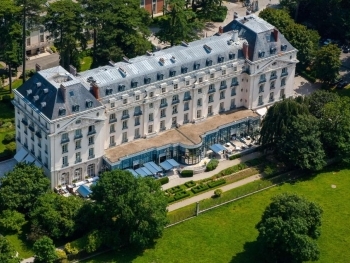Nestled in the heart of the Ozark Mountains, the Crescent Hotel in Eureka Springs, Arkansas, stands as a testament to grandeur, mystery, and history. This Victorian-era hotel, often dubbed "America's Most Haunted Hotel," has a storied past filled with intrigue, transformation, and a few ghostly tales. This article delves into the rich history, architectural splendor, and supernatural lore that envelop the Crescent Hotel, making it one of the most fascinating landmarks in the United States.
Origins and Construction
The Crescent Hotel was conceived in the late 19th century during a period when Eureka Springs was flourishing as a health resort, famed for its healing mineral springs. The town attracted thousands seeking cures for various ailments, prompting the need for luxurious accommodations.
Construction and Grand Opening
Construction of the Crescent Hotel began in 1884, spearheaded by the Eureka Springs Improvement Company and the Frisco Railroad. The project cost $294,000, a staggering sum at the time, and employed the expertise of architect Isaac L. Taylor. Taylor designed the hotel in the French Renaissance style, incorporating local limestone into the structure, which was quarried from the nearby White River.
The Crescent Hotel officially opened its doors on May 20, 1886. The grand opening was a lavish affair attended by dignitaries and the elite, featuring a grand ball and an elaborate banquet. The hotel boasted luxurious amenities including electric lights, modern plumbing, and an elevator—luxuries that were rare and highly coveted in that era.
The Golden Era
In its early years, the Crescent Hotel was the epitome of luxury and elegance. Guests enjoyed amenities such as horse-drawn carriage rides, a swimming pool, tennis courts, and extensive gardens. The hotel quickly became a favored destination for the affluent seeking the purported health benefits of the local springs, as well as a picturesque retreat from the bustling cities.
Decline and Transformation
Despite its initial success, the Crescent Hotel faced financial difficulties and changed hands several times. By the early 1900s, the hotel’s popularity waned as the craze for health resorts diminished and the nation faced economic challenges.
The Crescent College and Conservatory for Young Women
In 1908, the hotel found a new purpose as the Crescent College and Conservatory for Young Women. This prestigious institution provided a rigorous education, blending traditional academic subjects with fine arts. The college operated until 1934, after which the building reverted to a seasonal hotel.
The Norman G. Baker Era
One of the most infamous chapters in the hotel’s history began in 1937 when Norman G. Baker, a millionaire inventor and self-proclaimed medical doctor, purchased the property. Baker, who had no medical credentials, transformed the Crescent Hotel into the Baker Hospital, a health resort offering dubious cancer treatments.
Baker, known for his flamboyant personality and penchant for self-promotion, claimed to have discovered miraculous cures for cancer and other ailments. He lured desperate patients to his hospital with promises of recovery, despite his treatments being ineffective and often harmful. The Baker Hospital era ended in 1940 when Baker was convicted of mail fraud and sent to Leavenworth Federal Penitentiary. The hotel then fell into disrepair and remained largely abandoned for several years.
Revival and Restoration
In 1946, the Crescent Hotel was purchased by several investors who attempted to restore it to its former glory. However, it wasn't until 1997, when Marty and Elise Roenigk acquired the property, that significant restoration efforts truly began. The Roenigks invested over $5 million into the restoration, painstakingly preserving the hotel’s historic charm while updating it with modern amenities.
Today, the Crescent Hotel operates as a full-service resort, offering guests a blend of historic elegance and contemporary comfort. It features 72 guest rooms, a spa, a fine dining restaurant, and event spaces, making it a popular destination for weddings, conferences, and leisure travelers.
Haunted Legacy
The Crescent Hotel is perhaps most renowned for its reputation as a haunted hotel. Numerous guests and staff members have reported paranormal experiences over the years, contributing to its status as "America’s Most Haunted Hotel."
Notable Hauntings
Several spirits are said to inhabit the hotel, each with their own story:
- Michael: A stonemason who fell to his death during the hotel's construction. His spirit is said to linger in Room 218, often described as one of the most haunted rooms in the hotel.
- Theodora: A former cancer patient of Norman Baker's hospital, Theodora is often seen fumbling for her keys outside Room 419 and politely introducing herself as a patient before vanishing.
- Morris the Cat: The hotel’s beloved pet cat who was known as the "Hotel General Manager." Morris’s spirit is said to still wander the halls, especially around the lobby and basement.
Ghost Tours and Paranormal Investigations
The hotel embraces its haunted reputation by offering nightly ghost tours, which are highly popular among visitors. These tours take guests through the hotel’s most haunted areas, sharing spine-chilling stories and historical anecdotes. Additionally, the hotel has been featured on numerous paranormal television shows, further cementing its reputation in the world of the supernatural.
Architectural Significance
The Crescent Hotel is an architectural marvel, showcasing the grandeur of the French Renaissance style. Its stone façade, intricate woodwork, and ornate furnishings reflect the opulence of the late 19th century. Key architectural features include:
- The Crystal Dining Room: A spacious and elegant room with large windows, chandeliers, and period furnishings, serving as the hotel’s primary dining area.
- The Conservatory: A glass-enclosed space offering panoramic views of the surrounding landscape, perfect for relaxation and social gatherings.
- The Spa: Located in what was once the hospital’s morgue, the spa provides a unique blend of relaxation and history, offering a range of treatments that honor the hotel's heritage.
The Crescent Hotel stands as a captivating blend of history, mystery, and elegance. From its origins as a luxury resort to its time as a controversial hospital, and its revival as a premier destination for travelers and paranormal enthusiasts alike, the hotel’s story is rich and varied. Whether one is drawn by its architectural beauty, its storied past, or the allure of its haunted reputation, the Crescent Hotel remains a timeless landmark, inviting visitors to step back in time and experience the magic of Eureka Springs.












